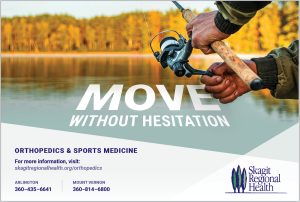
Who Needs Joint Replacement Surgery? is written by Christopher Sheu, MD, FAAOS, CAQSM; Skagit Regional Health. This is published in the 2025 Spring Summer Edition of Vibrant Senior Options Resource Guide Magazine and as an online post at VibrantSeniorOptions.com
The most common joint replacement procedures are hips and knees. However, ankles, shoulders, elbows and wrists can also be replaced. Dr. Christopher Sheu explores all that’s involved in a joint replacement.
Q: Do I Need a Joint Replacement?
A: As we age, a great deal of wear and tear occurs to our knees, hips, shoulders, elbows, ankles, and wrists. Sometimes, an incident of trauma — sports injury, vehicle accident — can result in having joint problems even sooner. Genetic factors can also contribute to joint deterioration.
For any of these situations, joint replacement surgery is a viable option. Surgical techniques and joint implants have progressed significantly over the last 10 to 20 years, allowing individuals faster recovery and less pain.
Q: What’s Involved in Joint Replacement Surgery?
A: When a joint begins to fail, the primary complaints include pain, weakness, and decreased function and/or range of motion. Depending on the joint, some patients also experience instability, locking, and catching.
When these symptoms become debilitating, it’s time to consider joint replacement surgery. We perform most of these surgeries in an outpatient surgery center where patients can return home the same day.
This can typically be done through a minimally invasive procedure with a small incision. Taking care to preserve the surrounding soft tissue, we remove the damaged joint surfaces and replace them with a prosthetic joint.
Following the surgery comes a time of recovery, where our physical therapy care team works with patients to regain their motion and strength and return to their full capacity. The physical therapy regimen varies depending on which joint has been replaced.
Q: How Do I Get Back to the Activities I Love?
A: Many come to me and say, “Why didn’t I do this sooner?” Most patients remark upon their increased motion, decreased pain, and freedom to get back to the activities they love doing.
I think it’s really important to keep people informed of the advancements in medical technology that are helping patients recover faster, do more, and stay more active.
Skagit Regional Health
Orthopedics and Sports Medicine
360-814-2663
Christopher Sheu, MD, FAAOS, CAQSM, practices Orthopedics and Sports Medicine at Skagit Regional Health. He is double board-certified and sees patients at Skagit Regional Health – Mount Vernon Surgery Center
Vibrant Senior Options Resource Guide Magazine





















